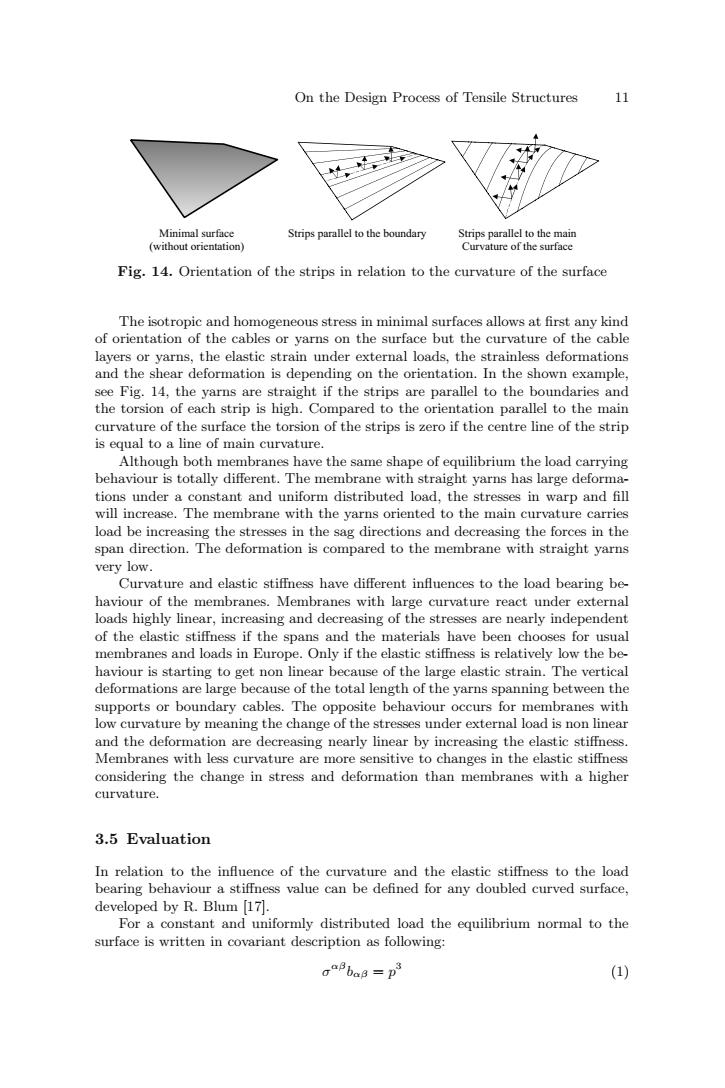正在加载图片...

On the Design Process of Tensile Structures 11 Minimal surface Strips parallel to the boundary Strips parallel to the main (without orientation) Curvature of the surface Fig.14.Orientation of the strips in relation to the curvature of the surface The isotropic and homogeneous stress in minimal surfaces allows at first any kind of orientation of the cables or yarns on the surface but the curvature of the cable layers or yarns,the elastic strain under external loads,the strainless deformations and the shear deformation is depending on the orientation.In the shown example, see Fig.14,the yarns are straight if the strips are parallel to the boundaries and the torsion of each strip is high.Compared to the orientation parallel to the main curvature of the surface the torsion of the strips is zero if the centre line of the strip is equal to a line of main curvature. Although both membranes have the same shape of equilibrium the load carrying behaviour is totally different.The membrane with straight yarns has large deforma- tions under a constant and uniform distributed load,the stresses in warp and fill will increase.The membrane with the yarns oriented to the main curvature carries load be increasing the stresses in the sag directions and decreasing the forces in the span direction.The deformation is compared to the membrane with straight yarns very low. Curvature and elastic stiffness have different influences to the load bearing be- haviour of the membranes.Membranes with large curvature react under external loads highly linear,increasing and decreasing of the stresses are nearly independent of the elastic stiffness if the spans and the materials have been chooses for usual membranes and loads in Europe.Only if the elastic stiffness is relatively low the be- haviour is starting to get non linear because of the large elastic strain.The vertical deformations are large because of the total length of the yarns spanning between the supports or boundary cables.The opposite behaviour occurs for membranes with low curvature by meaning the change of the stresses under external load is non linear and the deformation are decreasing nearly linear by increasing the elastic stiffness. Membranes with less curvature are more sensitive to changes in the elastic stiffness considering the change in stress and deformation than membranes with a higher curvature. 3.5 Evaluation In relation to the influence of the curvature and the elastic stiffness to the load bearing behaviour a stiffness value can be defined for any doubled curved surface. developed by R.Blum [17]. For a constant and uniformly distributed load the equilibrium normal to the surface is written in covariant description as following: ga8 0o8=p3 (1)On the Design Process of Tensile Structures 11 Fig. 14. Orientation of the strips in relation to the curvature of the surface The isotropic and homogeneous stress in minimal surfaces allows at first any kind of orientation of the cables or yarns on the surface but the curvature of the cable layers or yarns, the elastic strain under external loads, the strainless deformations and the shear deformation is depending on the orientation. In the shown example, see Fig. 14, the yarns are straight if the strips are parallel to the boundaries and the torsion of each strip is high. Compared to the orientation parallel to the main curvature of the surface the torsion of the strips is zero if the centre line of the strip is equal to a line of main curvature. Although both membranes have the same shape of equilibrium the load carrying behaviour is totally different. The membrane with straight yarns has large deformations under a constant and uniform distributed load, the stresses in warp and fill will increase. The membrane with the yarns oriented to the main curvature carries load be increasing the stresses in the sag directions and decreasing the forces in the span direction. The deformation is compared to the membrane with straight yarns very low. Curvature and elastic stiffness have different influences to the load bearing behaviour of the membranes. Membranes with large curvature react under external loads highly linear, increasing and decreasing of the stresses are nearly independent of the elastic stiffness if the spans and the materials have been chooses for usual membranes and loads in Europe. Only if the elastic stiffness is relatively low the behaviour is starting to get non linear because of the large elastic strain. The vertical deformations are large because of the total length of the yarns spanning between the supports or boundary cables. The opposite behaviour occurs for membranes with low curvature by meaning the change of the stresses under external load is non linear and the deformation are decreasing nearly linear by increasing the elastic stiffness. Membranes with less curvature are more sensitive to changes in the elastic stiffness considering the change in stress and deformation than membranes with a higher curvature. 3.5 Evaluation In relation to the influence of the curvature and the elastic stiffness to the load bearing behaviour a stiffness value can be defined for any doubled curved surface, developed by R. Blum [17]. For a constant and uniformly distributed load the equilibrium normal to the surface is written in covariant description as following: σαβbαβ = p3 (1) Minimal surface (without orientation) Strips parallel to the boundary Strips parallel to the main Curvature of the surface